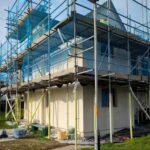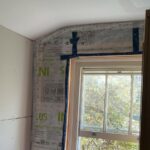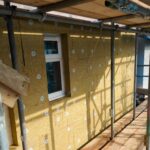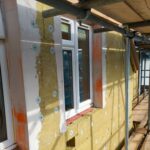In CWI, EEM, EWI, GFI, IWI, Retrofit by Robert Wheeler / 19 December 2023 / 0 comments

When it comes to optimizing energy efficiency in buildings, retrofit insulation has emerged as a valuable solution. Retrofitting insulation involves upgrading or adding insulation to existing structures, offering a range of benefits such as improved energy efficiency, enhanced comfort, and reduced utility bills.
This blog post explores the worthiness of retrofit insulation, delving into its advantages, cost considerations, energy savings potential, environmental impact, potential challenges, and success stories. By examining these factors, we can gain a comprehensive understanding of whether retrofit insulation is a worthwhile investment for homeowners and building owners alike.
Introduction to Retrofit Insulation
What is retrofit insulation?
Retrofit insulation is like giving your home a cosy sweater to keep it warm and energy-efficient. It involves adding insulation to an existing building to improve its thermal performance. Whether you live in an old house that feels like a freezer in winter or a sweltering oven in summer, retrofit insulation can be a game-changer.
The importance of insulation in buildings
Insulation is the unsung hero of a comfortable home. It helps regulate indoor temperatures, keeping the heat in during winter and out during summer. By creating a barrier against outdoor elements, insulation reduces heat transfer, minimizes drafts, and helps maintain a consistent and comfortable indoor environment. Plus, it can even contribute to better soundproofing and improved indoor air quality. Trust us, your home will thank you for the added cosiness!
Benefits of Retrofit Insulation
Improved energy efficiency
Insulating your home’s walls, roof, and floors can significantly enhance its energy efficiency. By reducing heat loss or gain, you’ll rely less on your heating and cooling systems, resulting in lower energy consumption and utility bills. Plus, who wouldn’t want to reduce their carbon footprint while saving a few bucks?
Enhanced comfort and indoor air quality
Say goodbye to shivering in your own living room or sweating buckets in your bedroom. Retrofit insulation helps create a more consistent and comfortable indoor environment. It eliminates cold spots, drafts, and excessive heat, making every corner of your home cosy and inviting. Additionally, insulation can act as a barrier against moisture and outdoor pollutants, improving indoor air quality and promoting a healthier living space.
Reduced utility bills
Let’s talk about the green stuff – money! Retrofit insulation can be a wise financial investment. By minimizing heat loss or gain, you’ll see a significant drop in your monthly energy bills. The initial cost of insulation is typically outweighed by the long-term energy savings and increased property value. So, your wallet will thank you for making this smart upgrade.
Cost Considerations
Initial investment and long-term savings
Sure, retrofit insulation requires an upfront investment, but think of it as a long-term relationship. The money you’ll spend on insulation will pay you back by reducing your energy bills for years to come. It’s like having a money-saving friend you never knew you needed.
Available financing options
If the thought of shelling out a lump sum for insulation sends shivers down your spine (and not the good kind), don’t worry. There are plenty of financing options available to make the cost more manageable. From government-assisted programs to low-interest loans, you’ll find a fitting solution to make your retrofit insulation dreams a reality.
Return on investment calculations
You may be wondering, “Is retrofit insulation really worth it?” Well, let’s crunch some numbers. By calculating your potential energy savings, factoring in the cost of insulation, and considering the long-term benefits, you can estimate your return on investment. Spoiler alert: it’s usually a pretty solid deal.
Energy Savings Potential
Understanding the impact of retrofit insulation on energy consumption
Retrofit insulation isn’t just about comfort; it’s also about energy conservation. By understanding how insulation affects your energy consumption, you’ll realize the magnitude of potential savings. From reduced heating and cooling needs to minimized energy waste, insulation can make a significant dent in your energy consumption.
Estimating potential energy savings
While we can’t predict your exact savings (we wish we were mind readers), we can assure you they’ll be substantial. The exact amount varies depending on factors like climate, insulation type, and your home’s current state. However, rest assured that retrofit insulation can result in impressive energy savings that will make you a proud and efficient homeowner.
Case studies showcasing significant savings
Don’t just take our word for it; let’s look at some real-life examples. Numerous case studies have documented the energy savings achieved through retrofit insulation. From homeowners slashing their heating bills in half to commercial buildings reducing their energy consumption by significant percentages, these success stories provide a clear picture of the savings potential. Prepare to be inspired!
Environmental Impact
Reducing carbon footprint
Retrofit insulation is a fantastic way to reduce your carbon footprint. By improving the energy efficiency of your home or building, you can significantly decrease the amount of energy required for heating and cooling. This means less reliance on fossil fuels and lower greenhouse gas emissions.
Contributing to sustainability goals
Investing in retrofit insulation aligns with sustainability goals on multiple fronts. Not only does it reduce energy consumption and greenhouse gas emissions, but it also helps conserve natural resources by minimizing the need for additional heating or cooling systems. It’s a win-win for both the environment and your pocket.
Comparison with other green building practices
When it comes to green building practices, retrofit insulation stands out for its cost-effectiveness and impact. Unlike other practices that may require extensive modifications or equipment, retrofitting insulation offers substantial energy savings without breaking the bank. It’s a practical solution that yields significant environmental benefits.
Potential Challenges and Limitations
Compatibility with different building types
While retrofit insulation can be applied to various building types, there may be compatibility challenges for certain structures. Historical buildings or unique architectural designs, for example, may require more tailored solutions. It’s essential to consult with experts who can evaluate the feasibility of retrofit insulation for your specific building type.
Obstacles in retrofitting existing structures
Retrofitting existing structures can present its fair share of challenges. Accessibility to wall and floor cavities, as well as the presence of asbestos or other hazardous materials, may complicate the insulation process. Conducting a thorough assessment beforehand can help identify potential obstacles and ensure a successful retrofit.
Dealing with insulation materials and their impact
Insulation materials have come a long way in terms of sustainability, but it’s still important to consider the environmental impact. Some insulation materials may have higher embodied energy or contain harmful substances. However, with careful selection and proper disposal practices, these concerns can be mitigated.
Case Studies and Success Stories
Successful retrofit insulation projects
Numerous retrofit insulation projects have achieved remarkable results. From residential homes to commercial buildings, success stories abound. These projects demonstrate the tangible benefits of retrofit insulation, showcasing energy savings and improved comfort levels.
Real-life experiences and testimonials
Hearing from individuals who have undertaken retrofit insulation projects can provide valuable insights. Personal experiences and testimonials can shed light on the process, challenges faced, and the ultimate benefits reaped. Their stories can serve as inspiration for those considering their own retrofit insulation journey.
Lessons learned from past implementations
As with any endeavour, past implementations of retrofit insulation have taught us valuable lessons. These lessons encompass best practices, innovative techniques, and areas for improvement. By learning from previous experiences, we can ensure more efficient and effective retrofits in the future.
Conclusion and Final Thoughts
Retrofit insulation holds immense environmental value, reducing carbon footprints and contributing to sustainability goals. While there may be challenges to overcome, the benefits are substantial. With success stories and lessons learned guiding us, it’s clear that retrofit insulation is a worthy investment for both the environment and building owners. So, let’s insulate and let our buildings celebrate a more energy-efficient and comfortable future!
Considering the numerous benefits and potential energy savings, retrofit insulation proves to be a worthwhile investment for homeowners and building owners. Not only does it improve energy efficiency and reduce utility bills, but it also enhances comfort and contributes to sustainability goals. While there may be some challenges and limitations to overcome, the positive impact of retrofit insulation on both the environment and the occupants of a building cannot be overlooked. By carefully assessing the cost considerations and exploring available financing options, individuals can make informed decisions about implementing retrofit insulation projects. In conclusion, retrofit insulation is a valuable solution that offers long-term benefits and should be seriously considered for improving the energy performance of existing structures.
Retrofit Insulation FAQs
Retrofit insulation can be applied to various types of buildings, including residential homes, commercial buildings, and industrial facilities. The suitability of retrofit insulation depends on factors such as the existing construction, the condition of the building envelope, and the insulation materials used. Consulting with an insulation professional can help determine the best approach for different building types.
Yes, retrofit insulation can lead to significant savings on utility bills. By improving the energy efficiency of a building, retrofit insulation reduces the amount of energy required for heating and cooling. This results in lower energy consumption and, consequently, reduced utility costs. The exact savings will vary depending on factors such as the insulation materials used, the climate, and the overall energy consumption patterns of the building.
The time it takes to recoup the investment in retrofit insulation depends on various factors, including the cost of the project, the energy savings achieved, and the local utility rates. Generally, homeowners can expect to recoup their investment within a few years, with ongoing energy savings continuing to accumulate over the lifespan of the insulation. Conducting a return on investment calculation specific to your situation can provide a more accurate estimate.
Retrofit insulation, when installed properly and using safe materials, does not pose any health or safety concerns. However, it is essential to choose insulation materials that are non-toxic and meet relevant safety standards. Additionally, proper ventilation and moisture management should be considered to prevent any issues related to indoor air quality or moisture accumulation. Consulting with insulation professionals and ensuring compliance with building codes and regulations will help address any potential concerns.
Ready to discuss your regeneration project and how NXTGEN Futures Ltd can elevate it with expert retrofit? Contact us today!
Latest Retrofit Posts
- What a retrofit-first approach offers the UKRetrofitting is like giving your home a makeover to make it more energy-efficient, comfortable, and healthy. The retrofit-first approach prioritizes upgrading existing buildings over new construction to tackle climate change and improve living conditions. Definition of Retrofitting Retrofitting involves making… Read more: What a retrofit-first approach offers the UK
- What is internal wall insulation?Internal wall insulation is a crucial component of creating a comfortable and energy-efficient living space. By insulating the walls within a building, homeowners can experience benefits such as improved thermal performance, reduced energy bills, and enhanced acoustic comfort. Understanding the… Read more: What is internal wall insulation?
- What is a retrofit assessor?Retrofit assessors play a crucial role in the sustainability and energy efficiency of buildings by evaluating and identifying opportunities for improvement. This blog post aims to provide an in-depth understanding of the responsibilities, qualifications, and benefits associated with being a… Read more: What is a retrofit assessor?
- What is a retrofit assessment in the UK?Retrofit assessments play a crucial role in the sustainable development of buildings in the UK, helping to improve energy efficiency, reduce carbon emissions, and enhance overall building performance. By evaluating existing structures and identifying opportunities for upgrades and enhancements, retrofit… Read more: What is a retrofit assessment in the UK?
- Retrofit and Energy Efficiency in Historic BuildingsHistoric buildings are not only architectural treasures but also valuable cultural assets that contribute to our sense of history and identity. However, many of these buildings often suffer from poor energy efficiency, leading to excessive energy consumption and high operating… Read more: Retrofit and Energy Efficiency in Historic Buildings
- What is retrofitting in construction?Retrofitting in construction is a crucial process that involves upgrading existing buildings or structures to meet modern standards of safety, energy efficiency, and functionality. This blog post explores the concept of retrofitting, its importance, various techniques used in the industry,… Read more: What is retrofitting in construction?
- CASE STUDY: Curtis WayDelivering a Holistic Retrofit Solution with EWI & Solar Energy Project Overview NXTGEN Futures Ltd. successfully completed a large-scale retrofit project on Curtis Way, Berkhamsted, England, UK. This case study showcases our expertise in External Wall Insulation (EWI), retrofit coordination,… Read more: CASE STUDY: Curtis Way
- What happens to a building during retrofitting?Building retrofitting is a vital process that involves making significant modifications and improvements to existing structures to enhance their efficiency, functionality, and sustainability. In this blog post, we will delve into the intricate workings of building retrofitting, exploring the various… Read more: What happens to a building during retrofitting?
- UK Government Retrofit Scheme: Making Energy Efficiency Cool AgainIntroduction to the UK Government Retrofit Scheme Background of the Retrofit Scheme Picture this: you’re sitting at home, snuggled up in your favourite blanket, enjoying a cup of tea, when suddenly you feel a draft. Not cool, right? Well, that’s… Read more: UK Government Retrofit Scheme: Making Energy Efficiency Cool Again
- What are Retrofit Trickle Vents?Improving indoor air quality and enhancing energy efficiency are key priorities for many homeowners. In this article, we will explore the concept of retrofit trickle vents and their role in achieving these goals. Trickle vents are small, adjustable openings integrated… Read more: What are Retrofit Trickle Vents?
- Retrofit Underfloor HeatingRetrofit underfloor heating has gained significant popularity as a cost-effective and efficient solution for enhancing the comfort and energy efficiency of existing buildings. Unlike traditional radiator systems, underfloor heating distributes warmth evenly across the floor, providing a comfortable and cozy… Read more: Retrofit Underfloor Heating
- Retrofit LondonRetrofitting has emerged as a crucial solution in transforming the landscape of cities, and London is no exception. As a global hub of culture, commerce, and innovation, London faces the pressing challenge of reducing its carbon footprint while ensuring sustainable… Read more: Retrofit London












